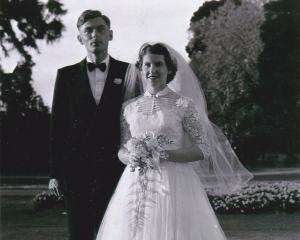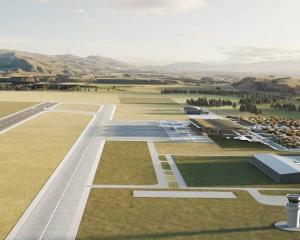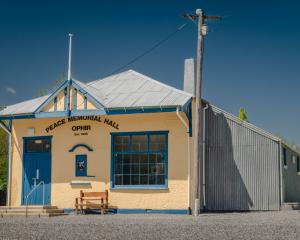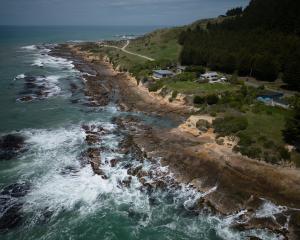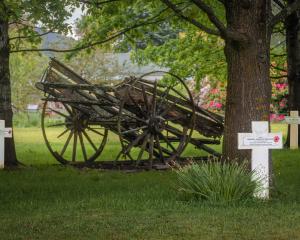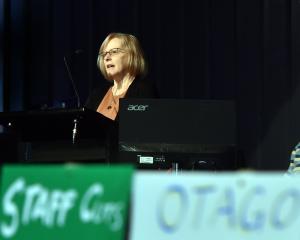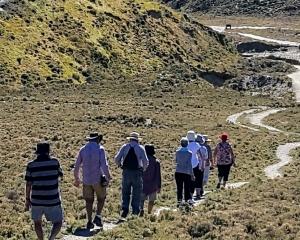About 100 years ago, a eager teenager lied about his age in Palmerston North to enlist in the Otago Battalion. Shawn McAvinue digs up his grandfather's military records and discovers a cabinetmaker signing up for military training in Dunedin to evade his older sister threats of stopping him joining World War 1.
On emptying a sock drawer in my father's Hastings home, the day after his funeral last year, I found a watch box with my grandfather's World War 1 medals and ribbons inside.
The box was stuffed in a thick woollen sock - my father's effort to secure the medals in a house he never locked.
In his wardrobe, I found two certificates I'd never seen for Private Thomas McAvinue.
The tattered certificates declared an honourable discharge from the New Zealand Expeditionary Force (NZEF) on April 3, 1916.
The other certificate lists his war service record (one year 234 days from August 14, 1914), medals awarded (1914-15 Star, British War Medal and Victory Medal) and theatres of war served (Egyptian 1914-15 and Gallipoli 1915).
In the box were three ribbons but just two medals; the 1914-15 Star was missing.
My grandfather died in 1965, 11 years before I was born, so I never heard any war stories - not that he told his family any.
On Christmas Day, a century ago, Pte McAvinue was in an Egyptian camp training to fight the Turks.
By uncovering his archived military records, visiting museums and historians and interviewing elderly relatives, I have pieced together a path to him being shot in ''the Daisy Patch'' at Gallipoli.
Pte McAvinue's military records reveal a ''smart and soldierly'' man with a couple of indiscretions during and after the war.
His war campaign ended like many others but the question remains: Why did he come to Dunedin to begin it?Cormack Thomas McAvinue, known as Tom, was one of six children - five boys and a girl - to Irish parents Patrick and Anne, who immigrated to New Zealand in the 1870s.
When Germany declared war on Russia on August 2, 1914, he was 19 and working as a cabinetmaker in Palmerston North.
Two days later, Britain declared war and New Zealand offered an expeditionary force three days after that.
Volunteers for the NZEF had to be aged between 20 and 46. On August 14, 1914, he told a recruiter in Palmerston North his birth date was May 20, 1894 - boosting his age by a year to be eligible.
He was one of 14,000 New Zealand men who volunteered in the first week and one of about 1000 men recruited to the Otago Infantry Battalion.
I assume the rest of the information on his enlistment form was true - a single Roman Catholic with brown hair, blue eyes, with dark complexion, 1.7m tall, 63kg with good teeth and ''full and perfect'' movement in his joints.
His eldest daughter, Phyllis Sant (89), of Hastings, the last surviving of four siblings, said her father told her he enlisted in the Otago Battalion because his elder sister Philomena had threatened to tell recruiters he was a teenager. Whether this was the reason, we will never know.
The cabinetmaker was deemed medically fit and was now a private in the 14th (South Otago) Regiment, with regimental number 8/838.
He left his family in Palmerston North and travelled to Dunedin for military training with the Otago Battalion at Tahuna Park.
The Otago Battalion was originally meant to sail from Dunedin on August 28 but the departure was postponed and on September 22, 1914, about 1600 Otago Infantry Regiment and Otago Mounted Rifles caught trains and rode horses to Port Chalmers in secret to board troop ships Ruapehu and Hawke's Bay.
The troops who would depart Dunedin on future sailings had grand farewells with official speeches and large crowds, but the first draft slipped away unannounced.
A couple of days later, the ships docked in Wellington Harbour and the men continued training at Trentham.
In mid-October, about 1000 Otago Battalion troops departed Wellington with the NZEF main body of about 8500 men and more than 3800 horses, on 10 ships.
The troop ships met the Australian troops in Albany, Western Australia, about a fortnight later.
The Australian and New Zealand contingents were convoying across the Indian Ocean when the United Kingdom declared war on Turkey on November 5.
After stops in Sri Lanka and Yemen, the convoy entered the Suez Canal, and arrived in Alexandria, Egypt in December.
The troops travelled by train to Zeitoun, near Cairo, to a camp on the edge of the desert, which would be their home and training base.
On January 25, 1915, the Otago Battalion travelled to support the Indian troops who successfully repulsed a Turkish attack on the Suez Canal.
As punishment for having a dirty rifle, Pte McAvinue was confined to barracks for five days from March 1.
About another 2220 New Zealand troops arrived at the camp on March 26.
With plans to knock Turkey out of the war, New Zealand and Australian troops departed Mustafa, Alexandria for Gallipoli Peninsula on April 10, under the command of a British general.
Landing on April 25, the New Zealand troops were welcomed by steep cliffs and an enemy superior in numbers and firepower.
About 930 Otago troops waded ashore and were ordered to the extreme left of the line and, when recalled, several Otago troops were killed.
On May 2, the Otago Infantry was involved in the attack on the hill ''Baby 700'', which was heavily defended by Turkish troops with machineguns.
After the battle, fewer than half the 800 Otago men who began the attack were fit for combat.
A week later, the surviving remnant of the Otago Battalion and other New Zealand forces joined a British infantry division at Cape Helles to fight Turkish troops at Krithia, a village about 6km from the Gallipoli Peninsula.
A British lieutenant-general with a poorly conceived battle plan repeatedly sent troops on daytime assaults across open ground.
Turkish snipers decimated the vulnerable troops with machinegun fire on an open field overgrown with red poppies and daisies, known as ''the Daisy Patch''.
On May 8, the second day of the five-day battle, Pte McAvinue was reported ''wounded and missing'' and The Manawatu Times published on June 17 that Patrick McAvinue had been told his son was wounded.
With a gunshot wound to his left hand, Pte McAvinue was recovering at a convalescent camp in Suez, Egypt on August 28.
''Wounds have healed but restriction of movement of fingers and wrist joint have made hand useless,'' medical records reported.
On October 21, The Manawatu Times reported Pte McAvinue was due to arrive in Dunedin on the ship SS Willochra, nine days later.
A doctor in Palmerston North in early 1916 reported the wound was slowly improving and recommended a stay at a Rotorua convalescent home for spa treatment and massage.
After an examination, the military assessed Pte McAvinue's capacity to earn a full livelihood in the general labour market had ''lessened by a quarter''.
Deemed medically unfit, he was discharged from the main body, about a year after leaving Egypt for Gallipoli.
After about six months of civilian life, he enlisted in the New Zealand Military Forces permanent staff and was appointed quartermaster sergeant, responsible for supplies and victualling for troops and animals.
After a year back in the military, he returned to Dunedin and found himself in trouble.
On a military charge report, dated February 12, 1918, QMS McAvinue was charged, for failing to salute an officer at the Dunedin Railway Station at 9.15pm, after passing the officer ''twice in a good light on the station with a lighted cigarette in his mouth''.
A lieutenant and two military police witnessed the offence.
Pte McAvinue could have had a few drinks on the night of the offence, because the next day, he failed to report to Otago Military District headquarters at 10am as ordered.
The case was dismissed.
Despite the dirty rifle in Egypt and smoking while failing to salute, his character was judged ''very good'' and he was considered ''smart and soldierly'' in 1917, 1918 and 1919.
His zeal was ''very good'' in 1917 and 1918 and ''fair'' in 1919 but his ''very good'' educational qualities in 1917 were deemed ''fair'' in 1918 and 1919.
He resigned from the military in August, 1919 in Palmerston North but, with the Great Depression looming, he wrote to the military in 1927 asking for work, prepared to ''accept any vacancy at whatever rank'' and ''travel to any place'' with his wife and 1-year-old child Phyllis.
No vacancies were available.
His son-in-law, Bill Roberts (87), of Hastings, said although his father-in-law's arm was ''virtually useless'' he never heard him complain about it.
Despite the injury, he bred and trained racehorses and bought 9ha of land in Pukahu, south of Hastings.
He lived in a tent on the land while building a family home and hand-milking 20 cows, delivering to houses from a horse-drawn milk float.
Not bad for a man with a capacity lessened by a quarter.
He then bought an ice cream factory and shop - The Blue Moon Dairy - on the main road between Hastings and Havelock North, and built stables out the back for his horses.
The shop had two bedrooms, where the McAvinue family of six lived.
There were four children, with 14 years between the oldest and youngest.
Over the road lived another World War 1 veteran, who had lost a leg in the war, and both men would go to a Havelock North pub for a pint or two, most days.
Ice cream sales soared in the Hawkes Bay heat and the family bought a bigger house.
When the final McAvinue girl got married, the ice cream business was sold as a going concern.
''He had lost all his staff,'' Mrs Sant said.
The medals and certificate are now mounted and hang in my Dunedin home, but should medals be polished and displayed?
My grandfather never attended dawn parades or the RSA, or talked of the war, so maybe the dark recesses of a sock drawer are a better place for the decorations of war.



